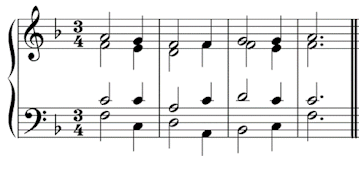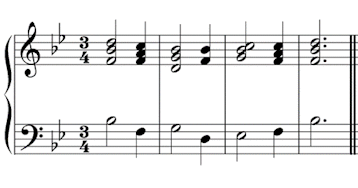Introduction to SATB Harmony
Chords are often written for four separate voices, parts or instruments, because a 4-note chord makes a richer sounding chord than a three-note chord. This is called 4-part harmony, or SATB.
“S” stands for soprano (the highest part), “A” is for alto, “T” is for tenor, and “B” is for bass, (the lowest part). Although these words are most often used to describe the human voice, they are also used to describe the four individual parts in music played by instruments too.
SATB chords can be written for the piano. You can find music where the two lower parts are on the left-hand stave, and the upper two parts are for the right-hand, like this:

Scheffler “Heilige Seelenlust”
The stems on the notes for the lower part on each stave (alto and bass) point downwards, and the higher parts (soprano and tenor) have their stems pointing upwards. This makes it easier to see which part any note belongs to.
Vocal SATB music and instrumental quartets are also sometimes written on a grand staff (treble and bass combined) in the same way. This is called a “short score”, because it takes up less space than writing individual parts.
Another way of writing SATB chords for piano is to write three notes into the right-hand, with just the bass notes in the left-hand.
This example is the same tune as above, but transposed up a 4th, into Bb major. As most of the tenor notes are now above middle C, it makes sense to include them in the right-hand part.

When writing SATB music for piano, always take into consideration the size and position of the human hand and take care to avoid impossible stretches or tangling of the fingers. (A one octave maximum stretch is a good rule of thumb).
In example A below, the tenor part Bb is difficult to reach with either hand. In B, it would be better to swap the alto and tenor notes around.
The Chorale
Chorales are a type of hymn which were popular during the Baroque era. Before chorales were invented, religious music had always been sung in Latin in churches across Europe. Then in 16th century Germany, Martin Luther began to write out hymns in the German Language, so that the congregation could more easily understand what they were singing about. These new hymns were called chorales.
Chorales became increasingly popular, and by the early 18th century the genre was widespread across Protestant Europe. JS Bach was particularly fond of chorales, and harmonised hundreds of them in 4-part (SATB) harmony. Bach’s chorales are fine examples of four-part harmony and are still used for teaching and learning harmony today.
Although chorales are often written on a treble and bass grand staff, similar to piano music, it’s useful to remember that they are in fundamentally a vocal style, and that each individual part would actually be sung.
This is the opening of Bach’s SATB setting of the chorale Nun danket alle Gott (Chorale 32). The pause marks at the end of each phrase match up with the end of each line in the sung text.
